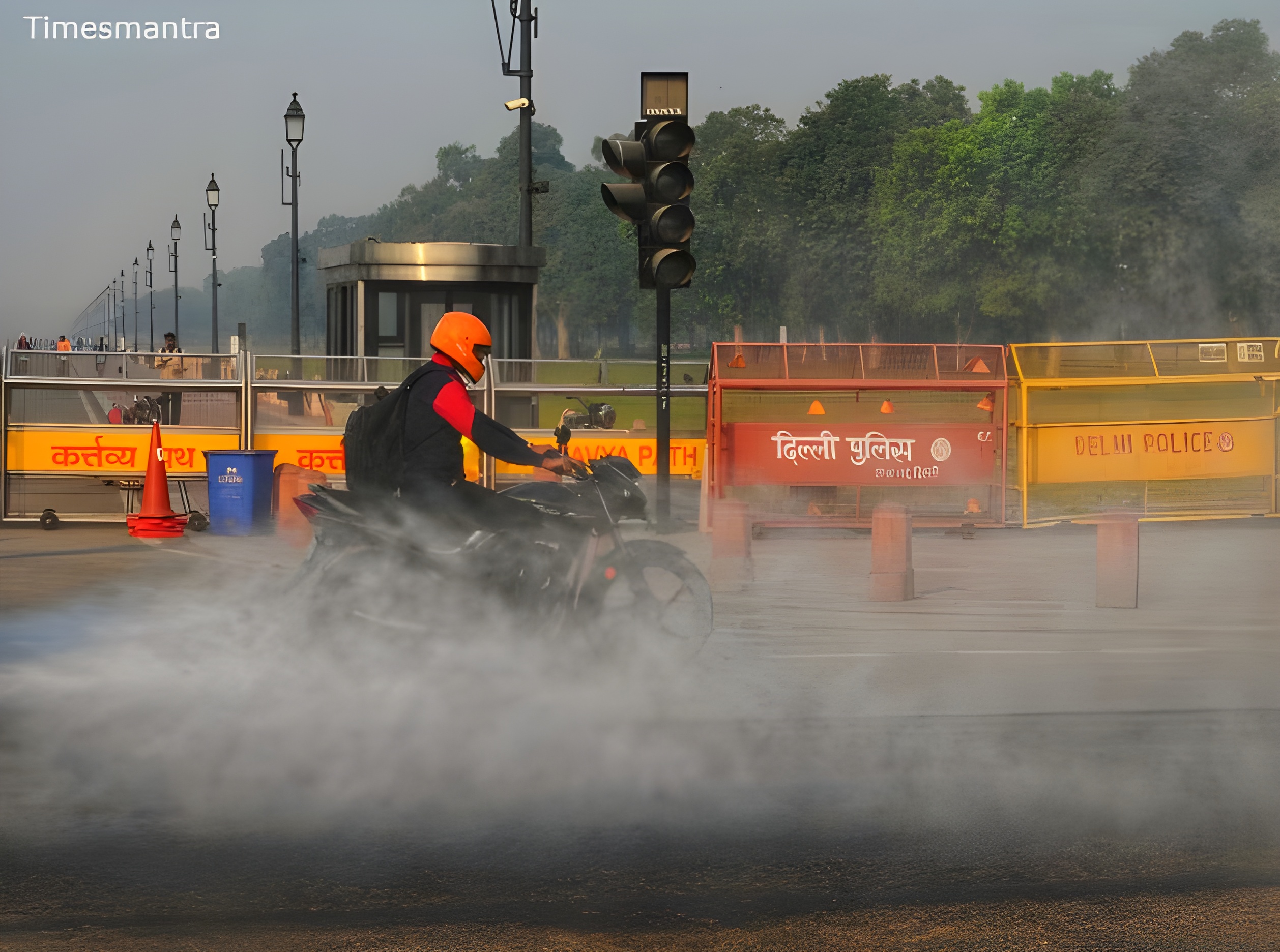GRAP-3 Enforced in Delhi-NCR as AQI Crosses 400 Threshold
New Delhi, November 11, 2025 – In a stark escalation of the capital’s annual battle against toxic air, the Commission for Air Quality Management (CAQM) has activated Stage 3 of the Graded Response Action Plan (GRAP) across Delhi-NCR effective immediately, as the Air Quality Index (AQI) plummeted to hazardous levels above 400 in multiple hotspots. This severe measure, triggered by the AQI breaching the “severe” threshold of 401 at Anand Vihar and ITO monitoring stations by 10:00 AM today, imposes stringent curbs on construction, industrial operations, and vehicular movement, aiming to mitigate the smog choking the region. With Diwali just weeks away and winter’s infamous inversion layer looming, the enforcement—announced by CAQM chairperson Dr. Prashant Gargava at a 12:30 PM press conference—comes as no surprise but underscores the deepening crisis of urban pollution in India’s political heartland. Temperatures holding steady at 22°C under a blanket of gray haze with visibility down to 200 meters, the alert isn’t a mere advisory—it’s an imperative, restricting 50% of Delhi’s construction sites and banning coal-based industries, while hybrid learning resumes in schools. As NDRF teams prepare for potential health emergencies and citizens don masks in the metro, November 11 marks a grim milestone in Delhi’s decade-long smog saga, where annual AQI spikes claim 2 million lives nationwide (Lancet 2024 study). With PM Narendra Modi chairing a virtual high-level meeting at 3:00 PM to review enforcement, this GRAP-3 activation demands not just compliance but a collective call to action in a city where air is the invisible enemy.
The CAQM’s decision to invoke GRAP-3, the third tier in the five-stage plan formulated in 2017 by the Supreme Court, was inevitable as Delhi’s AQI nosedived into the “severe” category, crossing 400 at 11:00 AM across 15 of the 36 monitoring stations operated by the Central Pollution Control Board (CPCB). Anand Vihar clocked 412, ITO 408, and Dwarka 405, driven by a toxic cocktail of stubble burning smoke from Punjab and Haryana (35% contribution, per IIT Kanpur’s SAFAR model) and vehicular emissions (25%). GRAP-3, detailed in CAQM’s November 10 notification, bans all construction except for linear projects like metro rail, shuts non-essential coal and diesel generator operations, and mandates 50% work-from-home for offices in Delhi and NCR districts. “This is a public health emergency; we must act decisively to protect vulnerable groups like children and the elderly,” Gargava emphasized, noting that AQI levels above 400 can cause respiratory distress within hours, with PM2.5 particles penetrating deep into lungs. Enforcement begins at 6:00 PM today, with flying squads from the Delhi Pollution Control Committee (DPCC) and Haryana’s HSPCB patrolling hotspots. Activation? Acute—GRAP-3’s grip, AQI’s abyss.
Delhi-NCR’s AQI crisis is a chronic affliction, the November spike a seasonal scourge exacerbated by winter’s inversion layer trapping pollutants in a 1,500-meter blanket. Today’s 400+ readings—up from 350 yesterday (CPCB 10:00 AM data)—are the worst since November 2023’s 450 peak, when schools shut for a week. Sources? Stubble burning 35% (Punjab 80% paddy residue burnt, Haryana 70%, ISRO satellite September 28), vehicular 25% (20 lakh daily cars, BS-III/IV diesel 40% emissions), industrial 20% (NCR’s 5,000 units, coal 60% fuel). Biomass from Diwali firecrackers looms, 2024’s 30% spike (CPCB). Crisis? Chronic—threshold’s terror, NCR’s nightmare.
GRAP-3’s restrictions are a rigorous regimen, Stage 3’s 10 measures a lockdown-lite to curb emissions 20-30% (CAQM 2024 study). Construction halt: 50% sites closed, only metro/highways exempt, dust suppression mandatory. Industries: Coal/diesel gensets banned, 100% PNG/CNG switch. Vehicular: BS-III petrol/BS-IV diesel cars banned entry Delhi, 50% WFH offices. Schools: Hybrid mode, no outdoor activities. Hospitals: Emergency generators only. Regimen? Rigorous—GRAP-3’s gauntlet, smog’s siege.
Causes confluence: Stubble burning’s seasonal scourge—Punjab’s 2.5 million hectares paddy residue, 80% burnt October-November (MoA&FW 2025), Haryana 70%—wafts 300 km to Delhi, PM2.5 35% (IIT Kanpur). Vehicular venom: NCR’s 15 million vehicles, 40% BS-III/IV diesel, 25% emissions (MoRTH 2025). Industrial ire: 5,000 NCR units, 60% coal (CPCB), plus 10% construction dust. Confluence? Catastrophic—causes’ cascade, crisis’s core.
Health havoc of AQI 400+ is harrowing, PM2.5 particles <2.5 microns invading alveoli, spiking respiratory cases 50% (AIIMS November 2024 study). Vulnerable: Children 30% asthma risk, elderly 40% COPD flare-ups, pregnant women 25% preterm births (Lancet 2025). November 2023’s 450 AQI hospitalized 10,000 (DPCC). Havoc? Harrowing—health’s hammer, haze’s hell.
Government’s gambit is a whirlwind of warnings and welfare, Sharma’s 8:00 AM cabinet September 28 activating Rajasthan State Disaster Management Authority (RSDMA). 22 NDRF teams Jaipur Jodhpur, 55 RSDR F units, 18 SDRF squads Ganjam-Kota, 110 power boats 8 choppers standby. SEOC coordinates IMD Jaipur, radar guiding 1.8 lakh evacuations—70,000 Jaipur lowlands, 60,000 Kota. Power Minister Avinash Gehlot 24/7 teams, 550 transformers prepped. Gambit? Government’s—whirlwind’s wisdom, rain’s rampage reined.
Evacuation efforts, launched September 27 dusk, target 2.2 lakh coastal hamlets, RSDMA door-to-door Jaipur 80,000 sheltered 220 cyclone centers 72-hour kits rice dal ORS. Jaisalmer’s dunes 30,000 Barmer shelters. Challenges: 40% resistance nomads, per Kemparaj September 28, mitigated incentives. Efforts? Evocative—evacuation’s essence, lives’ lifeline.
Economic fallout formidable, depression ₹15,000 crore damages—agriculture 80% hit kharif paddy 6 lakh hectares (Agriculture September 28). Fisheries 20% GDP ₹3,000 crore 90,000 boats grounded. Tourism 70% dip Udaipur lakes down (Tourism real-time). Fallout? Formidable—economy’s ebb, alert’s aftermath.
Climate change curse Rajasthan Bay 0.5°C warming 2000 5% intense (IPCC 2024). 2024 Barmer ₹7,000 crore 30 dead—2025 echoes NDMA 2025 35% frequency 2030. Curse? Crescendo—change’s challenge, Rajasthan’s rift.
Relief readiness forte post-2023 Jaipur 1.8M evacuations zero deaths blueprint 2025. 220 cyclone centers 2 lakh kits rice 5kg/person dal 1kg ORS 80,000 packets. Pradhan Mantri Awas ₹3.5 lakh houses 90,000 rebuilt 2024. Readiness? Resilient—relief’s regimen, rain’s reckoning.
Political palette prism alert BJP Pradhan “Congress negligence” 2023 echo Congress Sharma “central aid delay.” Modi’s visit Jharsuguda ₹18,000 crore Udaipur projects. Palette? Polarized—politics’ pigment PM’s pivot.
Community courage corridors Jaipur SHGs NRLM evacuate 9,000 (September 28 district). Kota’s Chambal fisherwomen 12,000 shelters tradition tenacity. Courage? Community’s—corridors’ call cyclone’s courage.
September 28, 2025, alerts severe—PM’s visit veiled Rajasthan’s rift. IMD oracle government’s gambit economic ebb community’s courage rain’s reign resilience’s rise.
